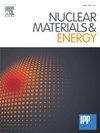Tungsten erosion during L-mode discharges in the DIII-D SAS-VW divertor
IF 2.3
2区 物理与天体物理
Q1 NUCLEAR SCIENCE & TECHNOLOGY
引用次数: 0
Abstract
A series of L-mode plasma discharges was performed in the DIII-D tokamak to assess the impact of outer strike point (OSP) position and toroidal magnetic field direction on erosion and core contamination potential of the recently-installed, tungsten-coated Small Angle Slot (SAS-VW) divertor. In one discharge, in-slot emission spectroscopy measured an < 48 % increase in the W gross erosion rate when the OSP was moved 3 cm outwards, away from the V-shaped vertex of the slot divertor. However, the effective W yield (erosion rate divided by the incident D flux) was, overall, insensitive to changes in OSP location. Consistently low estimates of the effective W yield based on measurements taken a few cm outwards from the vertex suggest potentially significant C surface contamination. No W emission signal was detected when orienting the toroidal magnetic field such that the ion B×∇B drift direction is pointed away from the X-point. However, measurements of W content in the plasma core for both toroidal magnetic field directions suggest the presence of additional, unmeasured sources of erosion. The difference in the measured core W density with OSP position is much greater than the difference in the measured erosion rates, which may suggest that the leakage of eroded impurities out of the divertor is governed primarily through the parallel ion temperature gradient and friction forces.
求助全文
约1分钟内获得全文
求助全文
来源期刊

Nuclear Materials and Energy
Materials Science-Materials Science (miscellaneous)
CiteScore
3.70
自引率
15.40%
发文量
175
审稿时长
20 weeks
期刊介绍:
The open-access journal Nuclear Materials and Energy is devoted to the growing field of research for material application in the production of nuclear energy. Nuclear Materials and Energy publishes original research articles of up to 6 pages in length.
 求助内容:
求助内容: 应助结果提醒方式:
应助结果提醒方式:


